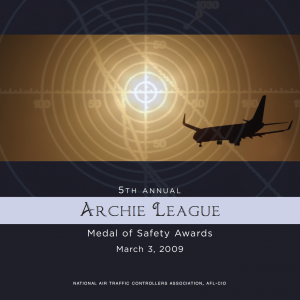
2009 – Winners of the 5th Annual Archie League Medal of Safety Awards, honored on March 3, 2009 at the Rio in Las Vegas:
Alaskan Region: Mark Harris, Anchorage TRACON
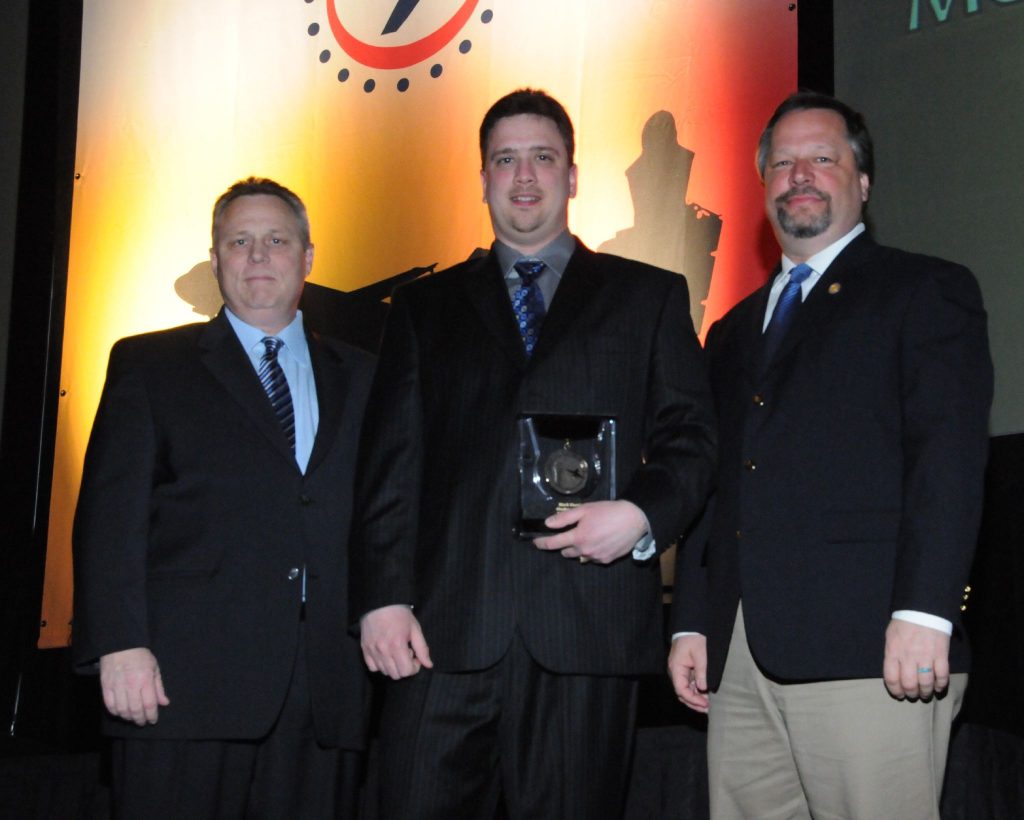
“I remembered my pilot’s friend, whose engine on his C182 Skylane seized over Turnagain Arm near the airport of Hope a couple of summers ago, telling me that when he was going down, it was comforting for him to know that a controller was watching him and summoning help,” describes Mark Harris of the thoughts going through his mind on Oct. 27, 2008 when an emergency call came in declaring smoke in the cockpit. “A calm voice on the radio keeps a scared pilot from becoming further rattled.”
Harris reacted quickly to the call by first taking over for the developmental he had been training due to the fact that this was her first emergency and she did not know what to do in such a situation. He would have to get the aircraft directly back to the airport that they had departed from as the trainee watched by his side.
Harris, though not aware of how much smoke there was within the aircraft, knew that no matter the amount it had to be a terrifying event when you are 4,000 feet in the air. He was determined to remain as calm as possible, ready to talk the pilot through descent to whichever airport he needed. He informed the pilot that he would have equipment ready, and the pilot said that he would exit the aircraft upon arrival. After making sure that the emergency was taken care of and rescue personnel were aware of the situation, he allowed the developmental to return to position.
“With as much training that we are doing these days, and as much knowledge that has retired, Mr. Harris is an example of why we need to keep our experienced controllers in NATCA and the FAA, and get back to a less hostile work environment,” says Anchorage Tower FacRep Marcus Tomlin.
Not only was Harris’ experience and skill evident on this day, but his quick assessment of the situation showed outstanding judgment. His snap decision to get the pilot on the ground as fast as he could, as well as instantly communicating with crash fire and rescue, was of paramount importance in this critical situation. He remained calm in effort to keep the pilot calm, while coordinating with three different facilities and his supervisor in order to get the pilot direct and on the ground safely.
“I was just one part of the overall picture, but I’d like to think an important part of a successful outcome,” says Harris. He most certainly was.
Not long after the event occurred, Harris was working North RADAR at Anchorage TRACON when he RADAR identified and began VFR flight following for a Cessna 90B on his frequency. This plane was the same plane he had helped just three months prior, and as evidenced by the coincidental encounter, the aircraft had been salvaged thanks to Mark Harris’ fine actions.
Read transcript of event highlights.
Central Region: Christian Manglona, Des Moines Tower/TRACON
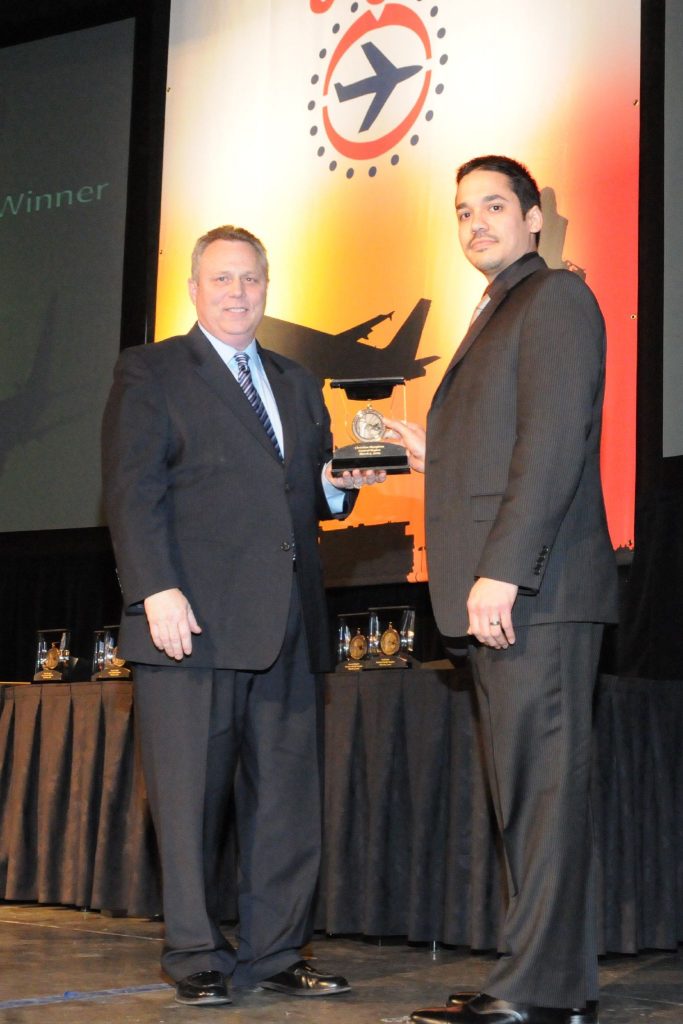
Panic set in for Cessna Caravan pilot, Timothy Gerber, on the night of Oct. 2, 2008, as he proceeded with his routine flight from Des Moines to Omaha. Catastrophic engine failure had struck the single-engine aircraft, leaving it stranded 4,000 feet over the dark Iowa countryside. Forced to radio a mayday call to DSM approach, Gerber suddenly found his life in the hands of radar controller on duty, Christian Manglona.
“Mayday, mayday. We have an emergency,” hears Manglona over his frequency. “We’re going down.”
The day’s traffic had diminished and the weather was clear, but Manglona knew that seconds could mean the difference between inconvenience and disaster for this Cessna pilot. He immediately used his knowledge and experience to orient the pilot to the nearest suitable airport.
“That’s a negative,” responds the pilot when asked if he can make the location. “We can’t make that. We are going to pick a road here and land on a road.”
The best suitable road for the flight to land on at night was behind him, and the only thing that lay ahead was unnavigable farmland.
Manglona decides that he must bring the troubled pilot to the second best alternative – a country highway. Performing with calm composure and professionalism, he remains in constant contact with the pilot to help him reverse his course towards two-lane Highway 169, just north of Winterset.
With fear now clearly displayed in the pilot’s voice, another pilot cuts in over frequency the encouraging words “keep flying, stay calm. Keep flying the plane all the way down.”
“I got some cars on the road. I’m going to try to land on that road,” reports Gerber, now face to face with the road ahead. “I’m going to try to follow the cars down.”
Manglona alerted local authorities and, with help from another unidentified pilot inbound to DSM, was able to relay information regarding the rescue assistance. Even after the plane touched down safely, Manglona continued alongside Gerber, offering advice and suggestions in order to prevent a surprise encounter with highway traffic.
As an air traffic controller, you must always think outside the box. You must expect the unexpected and Manglona did just this. His knowledge of the area and his quick-thinking capability, combined with the support of various pilots in the air, enabled him to land an engine-less aircraft in the middle of the countryside, and on top of that, set it down intact and unscratched.
Read the transcript of the event highlights.
Eastern Region: Steve Flickinger, Roanoke Tower/TRACON
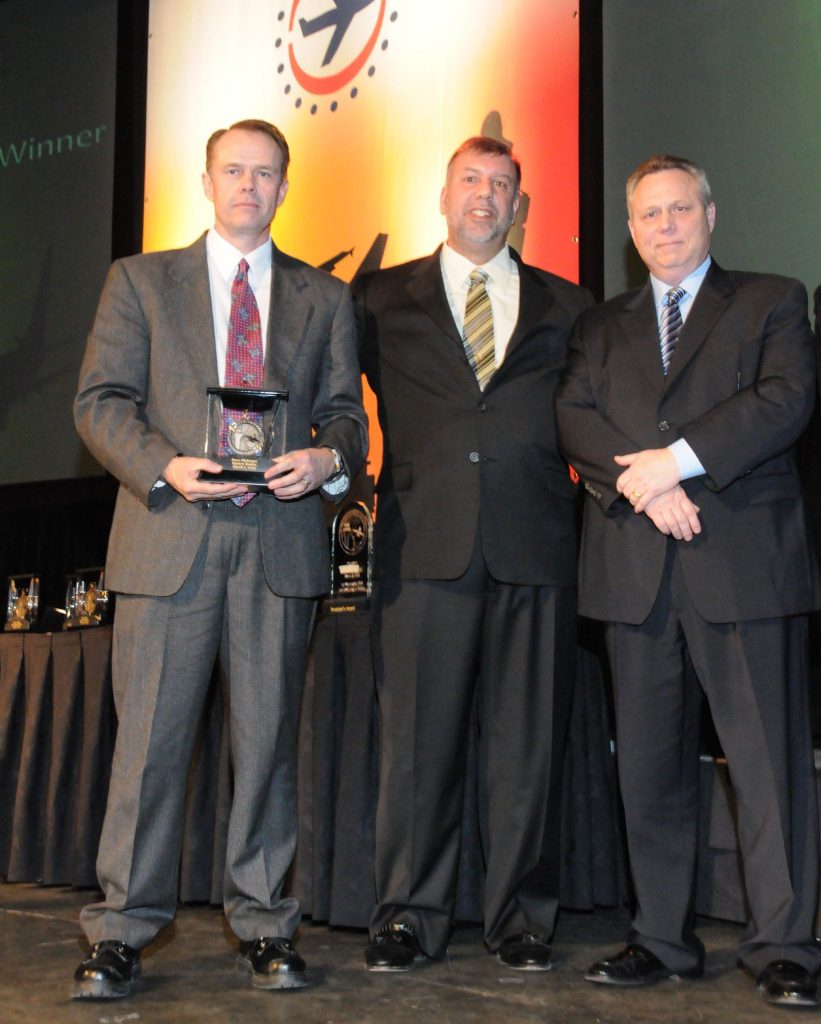
On Nov. 30, 2008, controller Steve Flickinger only had one chance, and one chance only, to bring N9118J safely into Roanoke.
He was working the ROA combined radar control position in the TRACON when the pilot of N9118J, en route from Detroit to Raleigh-Durham, needed a place to land due to strong headwinds. With only an hour left of fuel, the pilot would have to land at Roanoke Regional Airport, 15 miles south of his current position.
“You’re going to have to guide me into here,” explained the pilot. “I wasn’t expecting to be stuck here due to headwinds. I don’t have the approach plates.”
Steve would have to read through the LDA (Localizer Type Directional Aid) approach information necessary in order for the pilot to land. Fortunately, because of his familiarity with the local surroundings, he was able to do so as well as explain it in detail to the pilot unfamiliar with the somewhat uncommon procedure.
“It’s an ILS approach that is not lined up with the runway,” said Flickinger over radio, taking the extra time to make sure the pilot understood the necessary steps. “Basically it’s an ILS approach that is offset from the runway by 15 degrees. It won’t be straight ahead of you.”
In order to join the approach, the aircraft would have to be vectored out 15 miles because of the area’s mountainous terrain. Remaining in constant contact with the pilot, Steve gave the pilot course and altitude corrections so that the pilot could continue on a proper descent path to attempt a landing. The Roanoke LDA approach lay directly between two mountain ranges, which required Steve to pay careful attention to the aircraft’s course so that it didn’t veer to the left or right. It wasn’t until the aircraft was right over the runway that the pilot could visually pick up the runway and successfully land.
A missed approach was not an option for the pilot of N9118J. Though Steve gave the pilot part of the missed approach procedure, the aircraft didn’t have enough fuel to be granted a second try. Even after the successful landing, the aircraft only had about 30 minutes of fuel left, clearly not enough time to be vectored back out for another approach in the midst of strong headwinds.
In this specific case, precision and accuracy were vital in ensuring a safe landing. “Without Steve’s valuable assistance, I really doubt [the pilot] would have made it,” says ROA FacRep Don Stafford.
View a transcript of event highlights.
Great Lakes Region: Robert Zeman, Chicago Midway
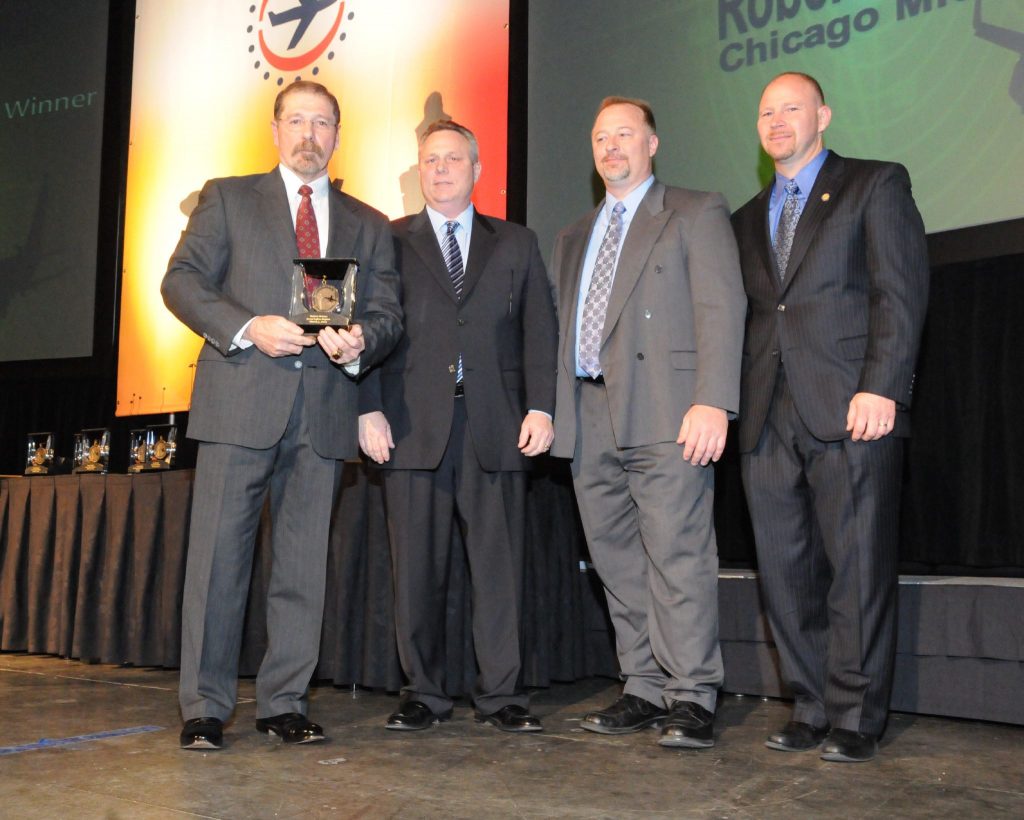
“Everything seemed normal until he was about 10 feet above the runway surface,” said controller Bob Zeman. Zeman was referring to Flight N612KB, an EA50 that was in the process of landing at Chicago Midway on June 5, 2008, when the routine procedure suddenly became anything but ordinary.
There were six to eight other planes in the pattern when Flight N612KB was cleared to land on Runway 22L. As N612KB touched down, the pilot suddenly declared to Zeman that he was going around due to winds.
Remaining calm and intensely focused, Zeman kept N612KB in a normal pattern to attempt another landing on Runway 22R. At that time the pilot of Flight N612KB notified Zeman that his engines were stuck and he may have to execute another go around.
“Keep me advised,” Zeman told the nervous pilot. “And let me know if you need any special assistance.”
Flight N612KB was issued a landing clearance again and Zeman set up the pattern to provide a clear path to the runway. At that time N612KB declared an emergency.
Zeman immediately relayed this information to his supervisor and C90 approach control. He then quickly and efficiently cleared the pattern of traffic to provide Flight N612KB a clear path to the runway, while also coordinating the deployment of the Chicago Fire Department and other emergency personnel. Flight N612KB was given clearance to land on any runway.
Using approximately 1,500 feet of runway, the aircraft landed on Runway 22R. Upon landing, Zeman immediately asked the pilot is he was okay and let him know that emergency response was on the way. Upon inspection of the Eclipse Jet, it was determined that both main landing gear tires were blown.
Without Bob Zeman’s skill, focus, professionalism, and teamwork, this emergency incident might never have had the happy ending that it did.
“Bob’s years of experience in air traffic control really showed that day,” said MDW FacRep Robert Mischke. “Bob is a credit to the profession and one of the best controllers at MDW.”
Read a transcript of the event highlights.
Great Lakes Region: Stephanie Bevins and Marvin McCombs, Cleveland Center
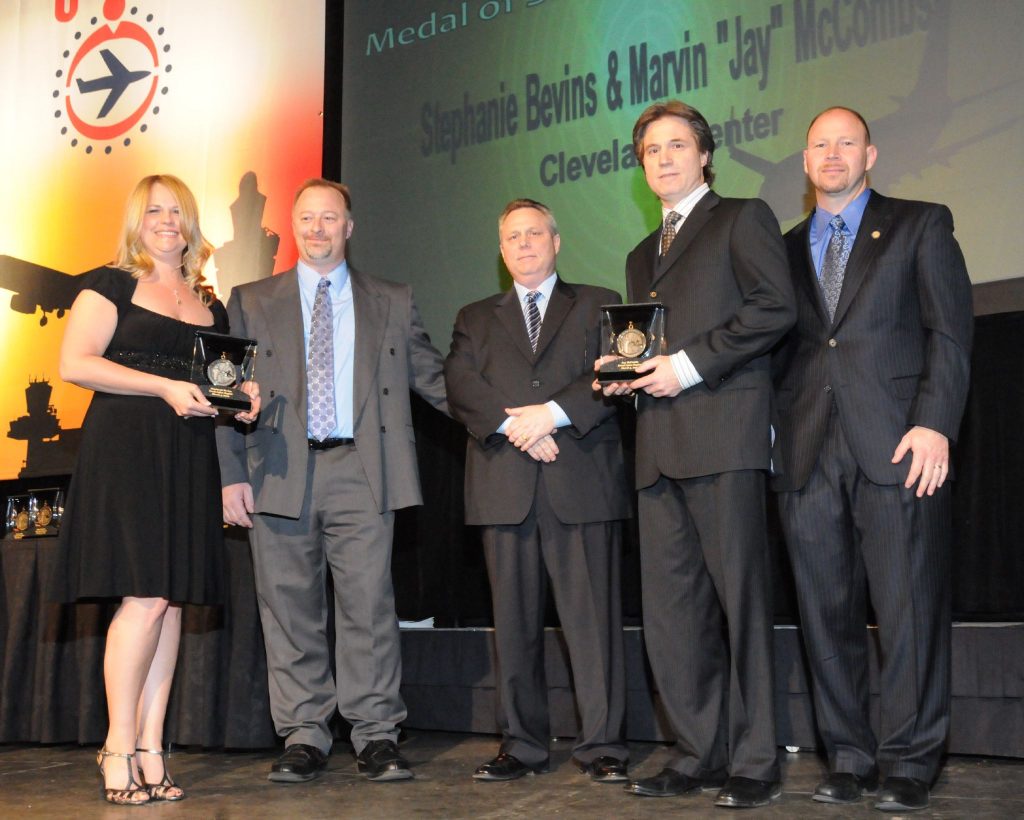
Over the radio, Jay McCombs tried hard to understand the slow, slurring words muffled among the blaring sirens in the background. The radio was poor, and the pilot difficult to understand, leaving only unintelligible transmission and uncontrollable noise to be heard.
Controllers at Cleveland Center were now faced with the complex and difficult task of deciphering the message if they had any chance of finding a solution. The critical diagnosis that was to come would make all the difference in securing the safety of the Kalitta Learjet, KFS66.
The events unfolded on July 26, 2008, when McCombs accepted the hand-off of KFS66, which appeared to have a stuck mike creating incomprehensible transmissions. Unclear to those at the Center, however, was that the co-pilot’s arm was moving violently and uncontrollably on the other end as the captain worked hard to fly the aircraft by hand.
Through the help of another pilot’s translation, Jay learned that the aircraft had declared an emergency. The plane was quickly changing altitude and McCombs immediately began to suggest closer airports, only to receive no reply.
Amid the chaos to translate the captain’s words, fellow controller Stephanie Bevins turns on the receiver so that she can now hear the pilot with her own headset. As she thinks through the pilot’s symptoms in her head, she concludes that he must be hypoxic, a serious condition involving lack of oxygen due to pressurization problems. She knows immediately that they must descend the aircraft.
Following Bevin’s initiative, McCombs begins bringing the aircraft to the lowest altitude possible in order to alleviate oxygen deprivation. Unable to answer questions, the pilot is only able to respond to direct commands that the controllers now begin to voice. “Descend and maintain,” they repeat.
Remarkably, the captain’s inability to turn on autopilot requires him to concentrate in order to fly the airplane, keeping him conscious and the plane airborne. The pilot’s words gradually become more understandable, and around 11,000 feet, he returns to normal and confirms that he had, indeed, been suffering from hypoxia.
Without Bevins and McCombs, there is no telling what would have happened. Bevins’ diagnosis made all the difference to the fate of the passengers, and without McCombs, the necessary actions to solve the problem would not have been taken to get the aircraft down safely. Various individuals were involved in the assistance of KFS66, clearly stated by McCombs who says that “the entire area (Area 5) worked extremely well as a team.”
Seeing that this is amazing story embodied by unusual and startling circumstances, it is clear why this case study has not only been chosen as an Archie winner, but also as a classroom teaching aid at the Civil Aerospace Medical Institute in Oklahoma City.
Read a transcript of the event highlights.
New England Region: Bruce Clough, Stephen Roebuck, John Therrien, and Bill Wood, Boston Center
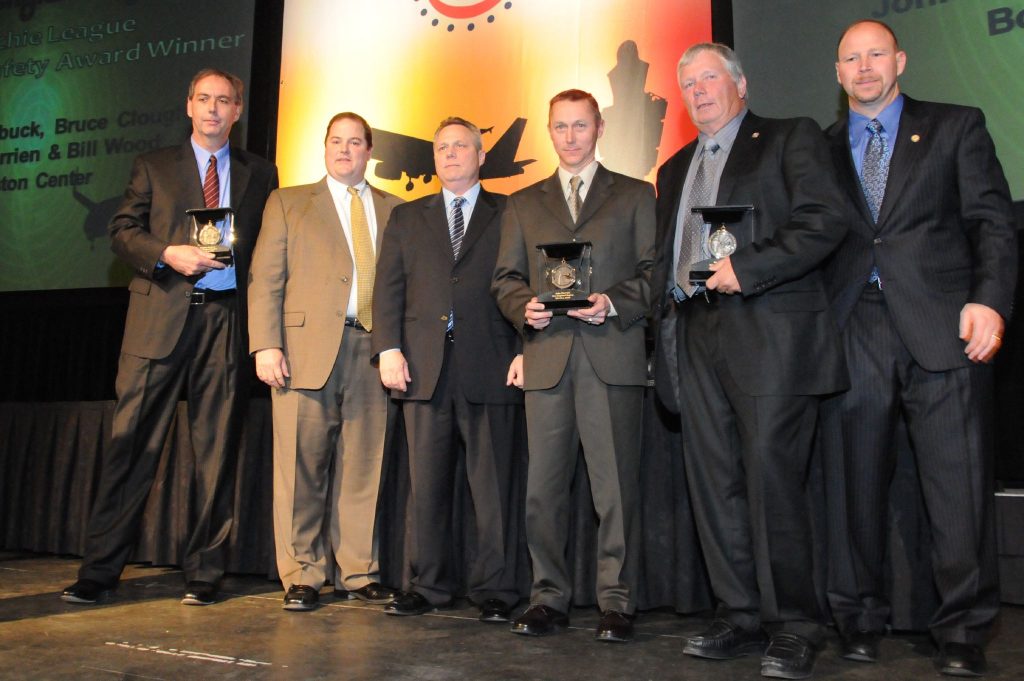
On Jan. 1, 2008, N83446, a Piper Seneca, was en route from Springfield, Vt. to Farmingdale, N.Y. when it experienced a failure of its vacuum pumps and, consequently, its gyros. Further complicating this serious situation was a combination of poor local weather conditions and a malfunction of the aircraft’s deicing boots – clearly a position no pilot would ever hope to find themselves in.
As a 26-year veteran controller, Stephen Roebuck quickly understood the urgency of the situation and immediately took necessary steps to provide assistance. “Stephen, himself a flight instructor, established a supportive rapport with the pilot of the aircraft in distress,” NATCA ZBW Area Rep Michael Dowd says of Roebuck’s efforts. “Stephen’s professional demeanor is such that he inspires confidence, an emotion a pilot experiencing a dual vacuum system failure in IMC conditions requires.”
In what can only be described as a model example of exceptional teamwork, Roebuck enlisted the support of fellow controllers on duty to assist with this developing situation. Moving in as the event unfolded, John Therrien assumed responsibility for sector operations so that Steve could give full attention to the aircraft in distress. He staffed an adjacent sector to better handle the workload and took control of traffic. In addition, Therrien alerted adjacent sectors and facilities of the emergency aircraft.
Bruce Clough, an experienced pilot and recently retired controller, was working in the radar position at an adjacent sector during the event, and provided valuable information on possible solutions to aid in the handling of N83446’s emergency situation. Clough also relayed input from a US Airways pilot on frequency regarding flight conditions and what might be more suitable destinations.
William Wood relieved Therrien of airspace and continued to provide the high level of support that his teammate had so strongly initiated. Wood’s efforts allowed the team to effectively assist this complex situation and permitted Roebuck complete focus on the troubled aircraft.
Together, the team worked to reassure the pilot and guide the aircraft towards the coastline where the Boston Center Weather Service Unit reported better weather conditions. With assistance from a US Airways pilot familiar with the operation of a Seneca’s navigational equipment, the team was able to provide necessary information for a successful recovery, while wisely verifying sufficient fuel and oxygen availability throughout the process. After making sure to inform Boston TRACON controllers of the situation, the group coordinated a successful handoff and the aircraft landed safely at Lawrence Municipal Airport.
Without a doubt, the help provided to this aircraft was a wide-ranging multi-personnel attempt. Each recognized the extreme seriousness of the situation and utilized their collective knowledge of aircraft and pilot capabilities, the potential dangers of spatial disorientation and oxygen deprivation, the local weather situation, and the dangers of flight in IMC conditions with limited flight instrumentation to create a plan which would result in a safe and successful conclusion to the situation.
The admirable teamwork of Roebuck, Clough, Therrien, and Wood averted what might otherwise have been a tragedy reported on the evening news, and instead guided the flight safely through inclement weather towards a successful landing.
Expertise from each of these veteran NATCA controllers contributed to this outcome, providing us all another example of just how important it is to have multiple experienced controllers on duty ready to respond to just such a serious event.
Read a transcript of event highlights.
Northwest Mountain Region: Thomas Hedeen, Denver Tower
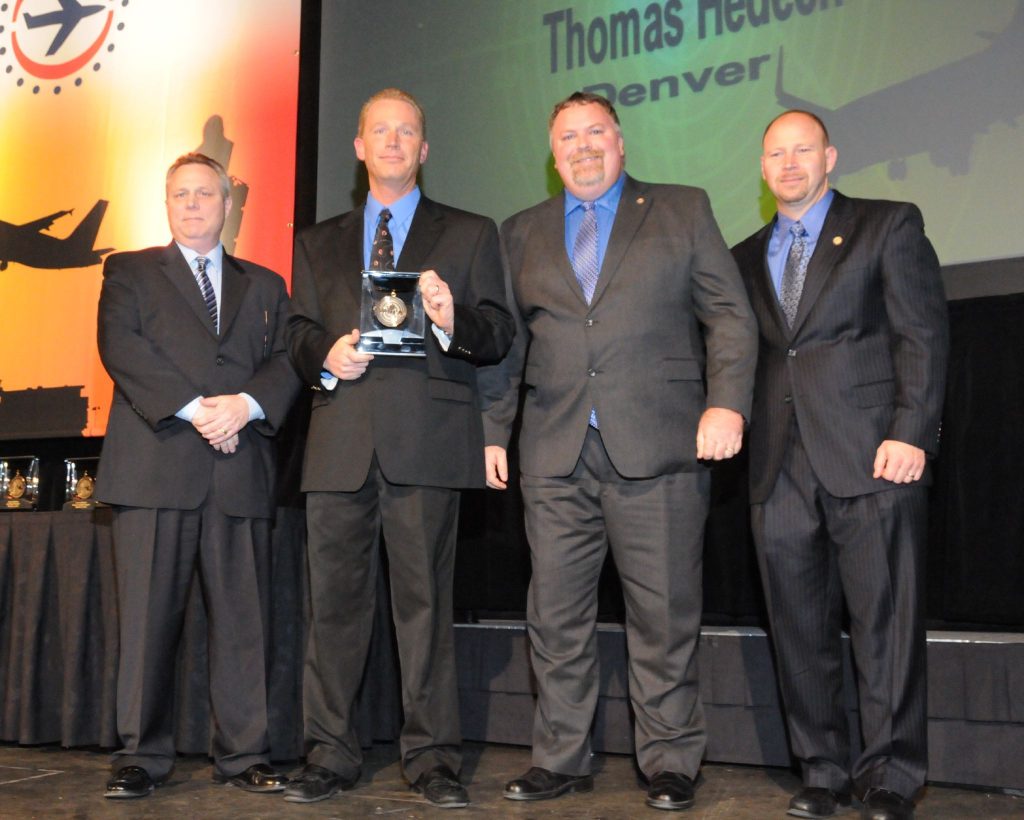
“Any ops vehicle on Denver Tower, any ops vehicle,” controller Tom Hedeen asks over the radio.
An aircraft has gone off runway 34R and Hedeen’s efforts to make contact with the pilot had just proved unsuccessful.
With no time to panic, instinct kicked in as Hedeen immediately took to his radio in an effort to get help – any help he could get. Continental Flight 1404’s takeoff had just gone terribly wrong.
The aircraft, a Boeing 737-500, was scheduled to fly from Denver to Houston on the evening of Dec. 20, 2008. At around 6:20 p.m. MST, it swerved off the runway into pitch darkness, skidding an additional half mile before coming to rest on the snow-covered ground. No fire, no smoke, just blackness.
With 54 square miles of land, Denver International Airport was now a vast maze of dark space to be searched. With no position on either airborne or ground radar, the controllers had only their eyes to rely on. As Hedeen sat searching, a thin foggy cloud drew his attention over the adjacent fire station lights, a rare circumstance amid the cold, clear night. After doing a double take, a dim orange glow began to faintly light the fog.
“West of Runway 34R, immediately north of Whiskey Charlie, immediately east of the fire house. On fire. In the ditch. Off the runway,” reported Hedeen to the rescue vehicles trying to find the crash site.
Aware of the fact that Denver’s fields lay 60 to 80 feet below the elevation of the runways, let alone hidden from the tower’s view even in full daylight, Hedeen knew the difficult task that lie ahead for the rescue team. Seconds meant the difference between life and death for those aboard 1404 and quick precision was a must.
Though the smell of burning jet fuel invaded the air, the aircraft remained invisible to those on the ground. The first fire truck out from the station turned away from the crash in a struggle to locate it, despite the clear and concise descriptions given by Hedeen. In an immediate need to correct the situation, he repeated the instructions over and over again, making sure that exact coordinates were given to responding emergency vehicles.
Visible flames now reached 100 feet into the night air as Denver controllers anxiously waited, in hopes that somehow some of the people on board had survived the impact. It soon became apparent, however, that these innocent passengers would unlikely escape the flames.
Perhaps Hedeen was the miracle Flight 1404 needed that day, as all 115 people aboard survived the crash, despite the massive impact and resulting fire damage. It took 45 minutes for information on the survivors to reach the tower; 45 minutes that will undoubtedly replay in the minds of those involved for quite some time.
Hedeen showed not only skill, but amazing amounts of composure as he took action among these adverse circumstances – composure consistent with the finest traditions of our profession. In the face of danger, he and his fellow controllers were able to put aside the magnitude of such an event, and what it might mean for those involved, in order to communicate the necessary actions.
“I cannot say enough about the controller crew that surrounded me that night and the job they did,” Hedeen says humbly in response to the event, despite the fact that he was simultaneously faced with close to 75 departures. “After the crash we lost 50 percent of our runway capacity. That crew continued to safely work hundreds more flights filled with thousands of people while an airplane full of people burned in front of them.”
“Ultimately, we had the eyes and they had the hands, and the combination worked,” Hedeen says of the rescue crew’s involvement, whom without, the Continental passengers would surely not have lived to tell the tale.
Read transcript of event highlights.
Southern Region: Kenny Ellis, Memphis Center
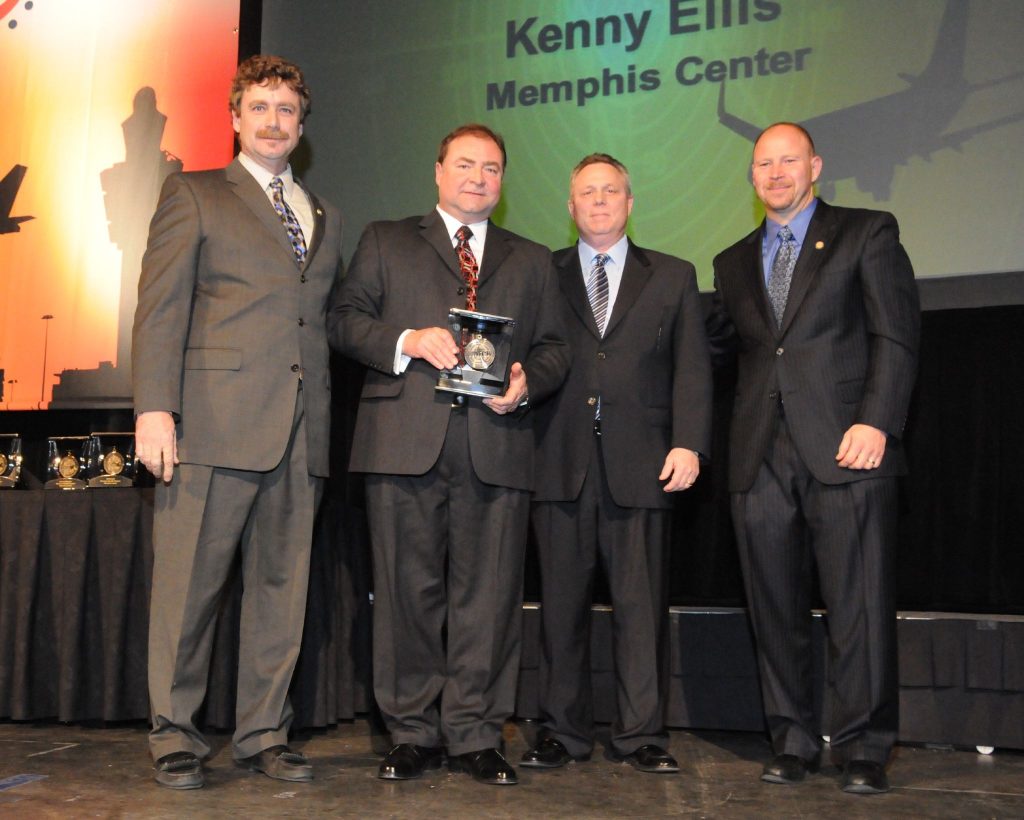
“What I saw on March 15, 2008, was a feat of airmanship I have never witnessed from the first-hand perspective.”
These are the words of controller Christopher Stephenson, and an opinion that is shared by many at Memphis Center when asked of Kenny Ellis’ efforts during an aircraft’s close-to-catastrophe moment.
Ellis was working Sector 33, a large sector in the North Area of Memphis Center, when things started to heat up, literally. A Hawker 800 had just come on the frequency requesting an emergency descent due to smoke in the cockpit, and the call couldn’t have come at a worse time. The aircraft was positioned in the narrowest, most complex area of the sector with the most crossing traffic, a fact that proved evident at this moment given that Ellis was already faced with at least two aircraft on converging courses in less than two minutes. He would now have to maneuver those, as well as the Hawker, out of harm’s way.
Ellis instantly reacted to redirect all aircraft not involved with the emergency and then, with what fellow ZME controller Jason Arnold refers to as “grace, poise and composure,” started in on helping the Hawker with its rapid descent.
“Descend and maintain, flight level 370,” directed Ellis quickly and decisively.
“Need lower,” responded the pilot in an attempt to follow the suggested altitude. “We’ve got smoke in the cockpit. We need lower.”
Conscious of the other aircraft in the area, Ellis attended to the two planes that were now moving along the troubled aircraft’s descending path. At the same time, he provided information to the aircraft that would be essential to a safe landing at the nearby airport in Cape Girardeau, Mo. (CGI).
“Cape Girardeau, turn right. It’s 55 miles to the west. I know you’re busy, just let me know…if you can’t answer me, I understand,” offered Ellis considerately as he continued to read out runway layouts, distances, vectors, and weather conditions.
“Mr. Ellis did an outstanding service, not only accommodating every request that N752CS had made, but also ensuring positive control and separation for the other aircraft that he was providing a service for as well,” wrote Arnold regarding Ellis’ efforts.
For air traffic controllers, time doesn’t stop when trouble arises. Aircraft continue flying and questions continue over frequency from pilots in the air. Not only did Ellis ensure a safe landing, but did so in a professional, quick, and steady manner.
Southern Region: Joe Mackie, Greenville-Spartanburg Tower/TRACON
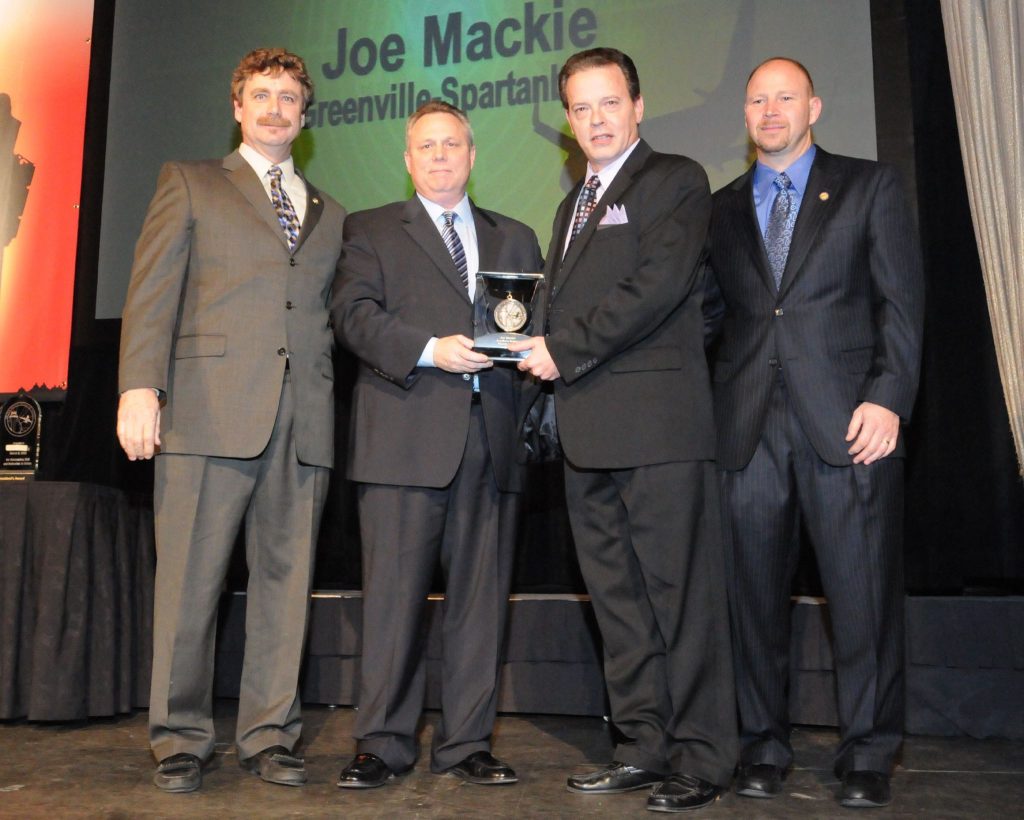
Six minutes can feel like eternity when you find yourself suddenly plummeting through the clouds without power. The only thing around to calm you is the voice at the other end of the radio, and on the morning of Aug. 28, 2008, that voice was Joe Mackie.
It was just an ordinary Thursday morning at Greer Tower when Bonanza 7741R pilot Jeff Green, headed towards North Carolina from Georgia, radioed Greenville-Spartanburg TRACON and was handed off to Mackie’s frequency.
The aircraft’s oil pressure had dropped to zero and the smell of burning metal filled the aircraft. With the cloud ceiling at 700 feet, the landscape below was invisible. He would need to land at the nearest airport.
With only the six minutes of flying time left for the troubled aircraft and an initial plan that would take 10, Mackie was quickly out of options. The pilot was unable to maintain altitude and, all the while, was getting more nervous. “I calmed myself down and decided that flying the airplane was the highest priority, I would rely on the controller to provide vectors and weather,” remembers Green when looking back at those fateful moments.
Mackie decided that he would just have to point the plane towards the runway, in hopes that the pilot would descend through the clouds and see the airport. He calmly gave directions so that the pilot would be in the right place when he came out of the clouds.
“I can land on a taxiway or anything, man,” Green says with uncertainty still evident in his voice, in which Mackie responded, “I’m just trying to keep your vectors as best as I can for the airport.” When the landing destination was within reach, Mackie relayed the information to the pilot saying supportively, “You’re almost over the runway now.”
“I got it,” Green replies with relief at his first sight of the airport. “I’m going to make it, sir.”
Without enough power to line up with the runway, the aircraft touched down in a grassy area about 20 feet shy of the runway. Despite the short landing, both the pilot and passenger were able to leave the incident without so much as a scratch.
Mackie had gotten the job done, and had done so with only his ability and 20 years of experience to rely on. Mackie realized the severity of the situation and was able to remarkably compare the descent rate of the aircraft with the distance remaining. It takes a strong person to stay cool in such a high stress situation, and Mackie’s judgment proved him to be a hero as he averted a potentially fatal situation.
To Mackie, this was just the everyday responsibilities of his job – keeping a calm voice for a pilot in need. In the eyes of pilot Green, it was much more. “I was totally reliant on Joe to navigate to the airport,” he says as he remembers the nerve-racking few minutes. “Whatever he said, and whatever I did to react, he put me on the end of the runway, and I’m able to talk about it today.”
Southwest Region: John Charlton, Lake Charles Tower/TRACON
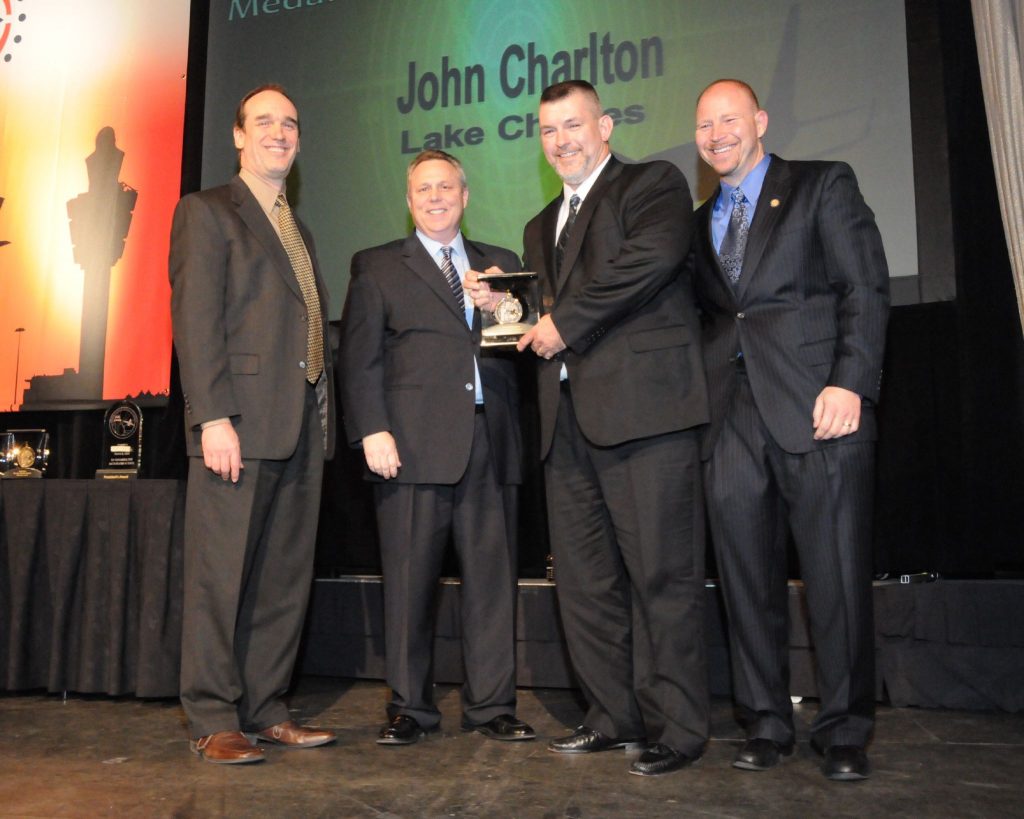
John Charlton displays dedication and professionalism continuously as an air traffic controller at LCH, and on Sept. 23, 2008, he once again went above and beyond to ensure a safe end result to a situation that could have easily ended in tragedy.
On this specific day, it was Charlton’s patience that saved the day. He was working local control when a Delta State University student pilot came over frequency requesting clearance. After clearing the Cessna 172 to land on Runway 15, Charlton watched as it made two unsuccessful attempts.
Charlton could sense the student was becoming flustered and, knowing what nerves could do in a situation such as this, he took it upon himself to provide some extra attention to the aircraft. After offering advice for a third attempt that proved unsuccessful, he alerted crash and rescue as a precaution for this risky predicament that had so quickly developed.
He instructed the pilot to do as he said without responding back. This would allow her to focus on his words, and his words alone. He spent the rest of the flight talking her through cross wind correction, keeping proper airspeed and finally through the instructions for cutting power towards descent. When the aircraft started to settle, he instructed the pilot to add pitch and, after a total of four unsuccessful attempts, the aircraft finally touched down successfully. Before ending the assist, Charlton made sure that the pilot had applied her brakes and taxied clear of the runway in order to not only ensure her safety, but the safety of those around her.
“[John’s] actions speak highly for the amount of dedication that he showed on this day and every day that he reports to work at FAA LCH ATC,” describes Lake Charles Regional Airport Director of Public Safety, Chad Primeaux, who has more than 18 years of experience in the airport public safety business. “If it had not been for Charlton’s professionalism and dedication to the job at hand, the end result would have been a totally different event than the one that occurred.”
Charlton demonstrated these significant qualities at such an imperative time, remaining calm and alert as he continued to work other aircraft and ground vehicles. In addition, he showed remarkable tolerance for the young pilot, one who was physically shaking from the traumatic experience she had just endured.
“Through the years, I have heard and witnessed a number of emergency situations involving aircraft,” wrote airport Executive Director Heath Allen in a letter to the Federal Aviation Administration. “I can’t say that I have ever observed such a devoted, extraordinary effort that Mr. Charlton gave to ensure that the young pilot landed safely and walked away unharmed.”
Below: Audio of this event.
Read transcript of event highlights.
Western Pacific Region: Neil Irvin and Tom Gallagher, Northern California TRACON
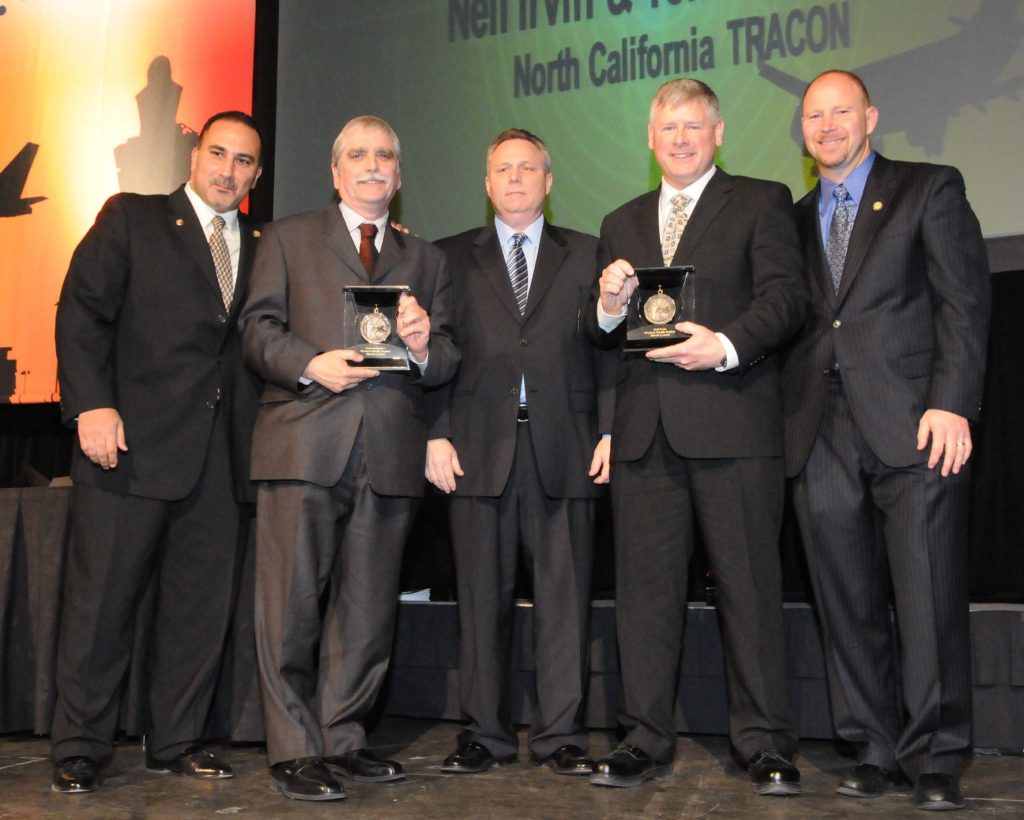
Imagine being thousands of feet up in the air, not knowing what was in front or below you. All you have to rely on is an unfamiliar voice, now acting as your only eyes, to guide you to safety.
On Nov. 2, 2008, the pilot of N40NL found herself in such a situation as rime ice accumulated on the windshield of her aircraft. The pilot checked on to frequency reporting the weather problem, as well as a loss of airspeed indicator. It was up to NCT controllers Tom Gallagher and Neil Irvin to take over as the middle men between the pilot’s uncertainty and the danger unfolding.
Tom Gallagher was working paradise position when he took the handoff from Oakland Center. It was sunset and the pilot was 12,000 feet over the foothills of the Sierras, clearly distraught over the position she had found herself in. Knowing that Neil Irvin, a flight instructor familiar with the operation of a Bonanza, was on break in the other room, Tom quickly retrieved him for help. Irvin plugged into the coordinator position and instructed Tom to have the pilot check her pitot heat. When she replied “I don’t think I have pitot heat on this,” it was apparent that Neil would need to provide much more attention to the pilot, as he knew for a fact that the aircraft did have the necessary equipment.
“Oh, I think I found it. I just turned it on,” declared the pilot in response to Irvin’s instructions. Irvin then suggested that the aircraft’s defrost also be turned on if the pilot felt comfortable. “And if you have a flashlight you may want to get it out and have it handy,” Irvin advised patiently, knowing that it would soon be getting dark.
As the pilot was brought down to 7,000 feet, the ice cleared off and Neil offered four airports in the area that the pilot could rest down at in order to avoid the line of heavy thunderstorms in the area. The aircraft’s fuel status was questionable, but the pilot was determined to land at her originally intended destination of Concord Regional Airport.
Irvin took this opportunity to ask about her airspeed indicator and learned that it was, in fact, back on. He continued to remind her of important and useful equipment information, telling her that she should look and locate her alternate air source.
“I don’t believe I know what that is,” responded the pilot as Irvin then takes the time to explain the alternate air source’s function and where it can be found.
Despite the complexity of this situation, Tom says that they were able to get the pilot down relatively quickly, just a few miles ahead of the approaching storm. “The pilot insisted on going on to Concord, but after 10 minutes she only had one hour of fuel left,” explains Tom. “We talked her into landing at Mather Airport in Sacramento. Right after she landed there, it started pouring.”
Due to Tom’s awareness of his teammates’ capabilities, he knew a fellow controller more knowledgeable of the specific aircraft was available at this critical time. Tom, however, views the event in a different light. “Neil had the experience to put himself, a pilot, in the cockpit to basically fly the plane,” says Tom of his partner’s skilled response that day. “Her voice immediately calmed down when Neil started talking. You could hear the impact his knowledge had on her.”
“I imagined being in the aircraft, working with her for solutions to each scenario,” Irvin says of his technique. “It was critical to have Tom assisting along with a good CIC to ease the workload of peripheral duties; this was critical in concentrating on the situation.”
One thing is clear. Both controllers made the right choices at the right times and, through a race against time and weather, transformed dangerous and complex circumstances into one happy ending.
President’s Award: John Charlton, Lake Charles Tower/TRACON
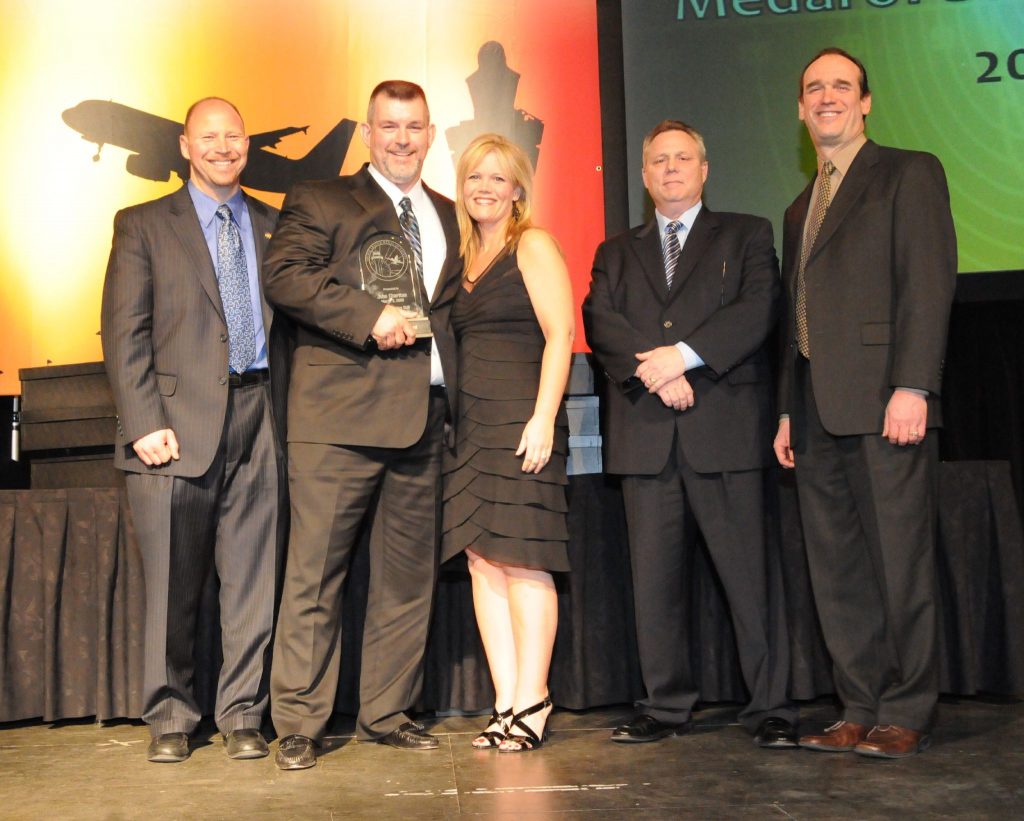
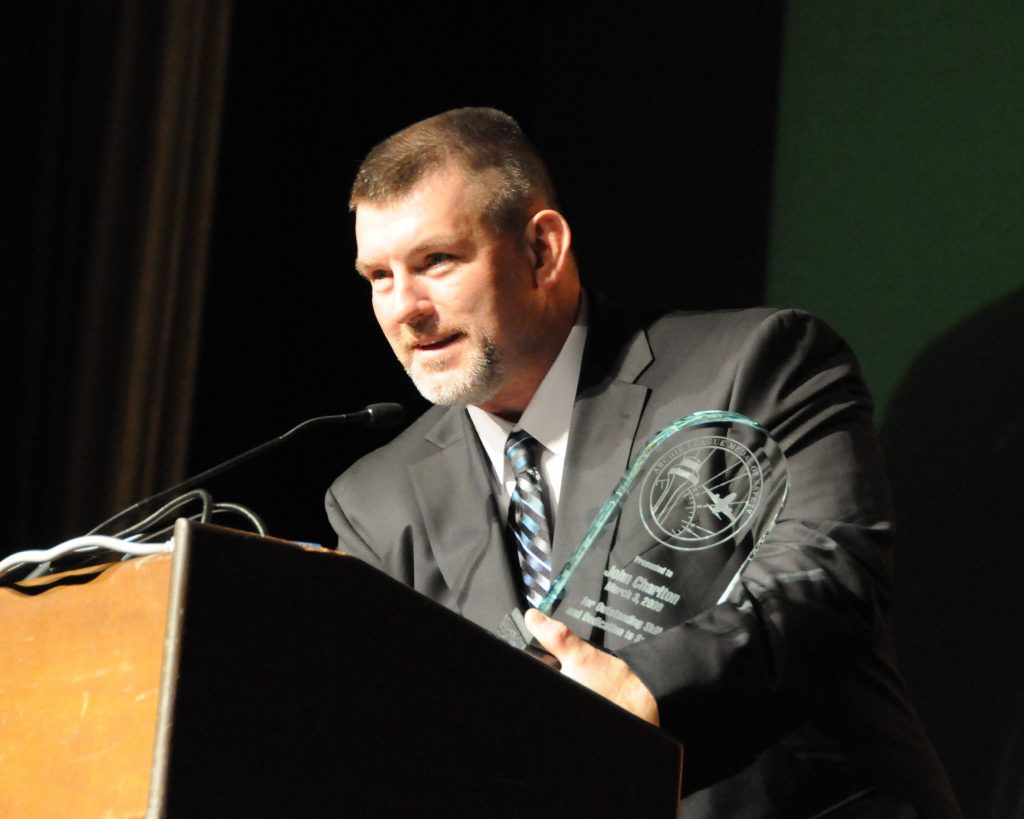
John Charlton displays dedication and professionalism continuously as an air traffic controller at LCH, and on Sept. 23, 2008, he once again went above and beyond to ensure a safe end result to a situation that could have easily ended in tragedy.
On this specific day, it was Charlton’s patience that saved the day. He was working local control when a Delta State University student pilot came over frequency requesting clearance. After clearing the Cessna 172 to land on Runway 15, Charlton watched as it made two unsuccessful attempts.
Charlton could sense the student was becoming flustered and, knowing what nerves could do in a situation such as this, he took it upon himself to provide some extra attention to the aircraft. After offering advice for a third attempt that proved unsuccessful, he alerted crash and rescue as a precaution for this risky predicament that had so quickly developed.
He instructed the pilot to do as he said without responding back. This would allow her to focus on his words, and his words alone. He spent the rest of the flight talking her through cross wind correction, keeping proper airspeed and finally through the instructions for cutting power towards descent. When the aircraft started to settle, he instructed the pilot to add pitch and, after a total of four unsuccessful attempts, the aircraft finally touched down successfully. Before ending the assist, Charlton made sure that the pilot had applied her brakes and taxied clear of the runway in order to not only ensure her safety, but the safety of those around her.
“[John’s] actions speak highly for the amount of dedication that he showed on this day and every day that he reports to work at FAA LCH ATC,” describes Lake Charles Regional Airport Director of Public Safety, Chad Primeaux, who has more than 18 years of experience in the airport public safety business. “If it had not been for Charlton’s professionalism and dedication to the job at hand, the end result would have been a totally different event than the one that occurred.”
Charlton demonstrated these significant qualities at such an imperative time, remaining calm and alert as he continued to work other aircraft and ground vehicles. In addition, he showed remarkable tolerance for the young pilot, one who was physically shaking from the traumatic experience she had just endured.
“Through the years, I have heard and witnessed a number of emergency situations involving aircraft,” wrote airport Executive Director Heath Allen in a letter to the Federal Aviation Administration. “I can’t say that I have ever observed such a devoted, extraordinary effort that Mr. Charlton gave to ensure that the young pilot landed safely and walked away unharmed.”
BELOW: Watch the award presentation.
BELOW: Watch and listen to highlights from this save event.
Honorable Mention
Central Region
Pat Pelkowski, Wichita Tower
Eastern Region
Alan Eldridge, Charleston Tower
Philip Gallagher, Wilkes-Barre Tower
Charles Huff, Wilkes-Barre Tower
Dave Harrington, Roanoke Tower
Glenn Weber, Roanoke Tower
Mark Duncan, Roanoke Tower
Vito Gioia, Farmingdale Tower
Great Lakes Region
Michael Giggie, South Bend Tower
Dean Pesato, Cleveland Center
Leslie Snyder, Evansville Tower
Stacey Parham, Cleveland Center
Frank Lewandowski, Cleveland Center
Northwest Mountain Region
John Schrock, Portland Tower
Mike Naiman, Denver Center
John Hultman, Pasco Tri Cities Tower
Southern Region
Dan Shaw, Memphis Tower
Barbara Walton, Daytona Beach Tower
Mark Doss, Memphis Center
Arys Rene Cabrera, Miami Center
Thomas Davis, Miami Center
Rhonda Swearingen, Memphis Center
Jay Hilligrass, Memphis Center
Ruth Marlin, Miami Center
Tracey Cogdill, Miami Center
Shailendra Chaudhari, Miami Center
Brent Evans, Knoxville McGhee Tyson Tower
Southwest Region
Bill Buvens, New Orleans Moisant Tower
Dale Campo, New Orleans Moisant Tower
Bob Gulley, New Orleans Moisant Tower
Brian LaFleur, New Orleans Moisant Tower
Chris Johnson, New Orleans Moisant Tower
Ronny Davidson, New Orleans Moisant Tower
Dave Blankenship, New Orleans Lakefront Tower
Ronald Alleman, New Orleans Lakefront Tower
Frank Smith, Oklahoma City/Will Rogers Tower
Paul Franklin, Austin Tower
Jennifer Harshbarger, Austin Tower
David Benedetto, Fort Worth Center
Tim Crone, Tulsa Tower
William DeBolt, Dallas/Fort Worth TRACON
Michael Woods, Dallas Addison Tower
Western Pacific Region
Gina Eckert, Gillespie/San Diego Tower
Ken Moen, Reno Tower
Mike LaGrange, Reno Tower
Jason Hughes, Los Angeles Center

